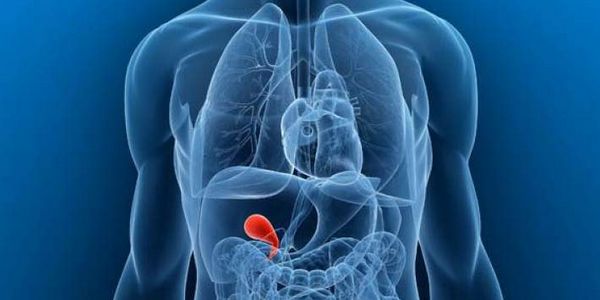Cholelithiasis – treatment of disease. Symptoms and prevention of diseases of cholelithiasis

Cholelithiasis – What is this disease? Cholelithiasis(from others. Greek χολή — zhjolch' iλίθος — gem) is the formation of concrements (stones) in the gallbladder and bile ducts. Cholelithiasis may subsequently lead to holecistitu.
Cholelithiasis – The cause of the
The process of formation of gallstones provokes two main factors-the stagnation of bile in the gall bladder and increasing the concentration of salts in the bile. Also, some diseases can become catalysts in the development of gallstones, such as diseases of the pancreas and biliary dyskinesia. Habits and lifestyle is of particular importance, unfavourable are overeating, improper and irregular meals, starvation, sedentary lifestyle, obesity.
Cholelithiasis – Symptoms of gallstones
In most cases, the disease is asymptomatic, especially, When the stones are in the gallbladder. Symptoms arise, When the concrements clog partially or completely bile ducts, breaking their accessibility, and causing pain.
When, When a gallstone is fully or partially overlaps the bile duct, the patient experiences pain. Nature of pain shvatkoobraznyj, gradually the pain slowly increasing, reaching the peak, and also slowly wanes. Pain syndrome can last for up to several hours, localization of pain is most often in the upper right abdomen.
You experience the following symptoms: nausea, vomiting, chills, fever, jaundice, abdominal distention, belching, flatulence, the feeling of overcrowding in stomach.
Cholelithiasis – Diagnostics
The main methods of diagnosis of cholelithiasis:
1. Biochemical blood analysis.
2. ULTRASOUND of the gallbladder.
3. Doudenal'noe sensing.
4. Radiography.
Cholelithiasis – Types of disease
Conditionally, We can distinguish several forms of cholelithiasis:
1. Latent form-does not have clinically manifestations, asymptomatic, is the phase of leakage illness, than a separate form of disease.
2. Dispepticheskaja chronic form. The main symptoms are: heartburn, flatulence, feeling of heaviness in the right podrebernoj area, unstable chair. The emergence of pain for this form, characterized by the use of oily, Fried and spicy foods or large amounts of food at one time.
3. Pain chronic form. For this form of the disease is the presence of pain, pain have nagging, no acute, location-right podrebernaja area. Characteristic are also weak, irritability and physical malaise.
4. Chronic relapsing form. This form is leaking badly, is different from sudden pains in the right podreberie exiles and podlojecna area. Provoked seizures, the use of spicy and fatty foods, high physical load, during pregnancy or menstruation.
Cholelithiasis – Actions of the patient
The patient's actions during the attack of gallstones:
– do not eat;
– to relieve pain, We recommend that you take a analgesic;
– consult a doctor, If the attack has a duration of more than 2 hours.
You must apply to face-to-face appointment with doctor, If there are frequent pain in the right hypochondrium.
Cholelithiasis – Treatment of cholelithiasis
In order to treat cholelithiasis using two basic methods of therapeutic or surgical depending on the flow of disease.
Therapeutic method includes:
1. Recommended dietary – diet number 5 . Food should be fractional (4-6 time eating). It is recommended to use dairy products and foods of plant origin. Excluded from the diet of fatty, Fried, acute, smoked food, alcohol, chocolate, spicy seasonings.
2. Use of drugs, that contribute to the dissolution of gallstones and their excretion of – ursodezoksiholevaja and chenodeoxycholic acid, urolesan etc. Their use is appropriate, when, If the stones are isolated and their size does not exceed the 2 centimeters. A course of treatment – 1-1,5 year.
3. Application of extracorporeal shock wave therapy (extracorporeal shock wave lithotripsy), belongs to the hardware method of treatment. Shows at stones measuring up to 3 see and if enough gallbladder contractility. Under the influence of this method occurs crushing holesterinovykh stones into smaller pieces, that appear naturally along with feces. Procedure bezboleznenna.
Surgical treatment, involves removal of the gall bladder.
1. Laparotomnaja cholecystectomy. The classic method, in the course of which the laparotomy (the incision on the abdomen), through which you removing the gallbladder with stones formed.
2. Laparoscopic cholecystectomy. Minimally invasive method, in the course of which through the small hole in the abdomen with special tools. Traces on the skin after surgery practically no because an incision of no more than 1 cm, significantly reduces the period of hospitalization compared to the classical method.
Tactics of treatment determines the attending physician depending on the form of the disease and the patient's condition.
Cholelithiasis – Complications
Often, gallstones are not dangerous, before the moment, yet stone doesn't clog bile duct, in this case it provokes inflammation in the gallbladder, pancreas and liver. If you do not carry out timely treatment, This can lead to rupture of the gallbladder and, Consequently, by peritonitu.
Chronic gallstones dangerous, that it may be one of the factors of developing cancer of the gall bladder.
Prevention of cholelithiasis
Basic methods of prevention of cholelithiasis:
1. Lower cholesterol in the blood.
2. Delete greasy and fried foods from the diet.
3. Normalize weight, If it exceeds the norm.
4. Exercise regularly.
